How Much Do Walk-In Tubs Cost in 2025?
Key Takeaways
- If you’re looking for bathroom accessibility solutions, walk-in tubs can be a great option to prevent falls and keep you independent.
- Walk-in tubs range in price, from $2,000–$10,000 for the tub and $1,000–$20,000 for installation.
- Most insurance plans do not cover walk-in tub costs, but Medicare Parts B and C may make exceptions.
- Look for programs that can offer financial assistance by using NCOA’s BenefitsCheckUp, or you can apply for the U.S. Department of Agriculture’s Rural Repair and Rehabilitation grants and loans.
- You can also save on walk-in tubs by looking for discounts, applying for financing, or filing as a tax deduction.
As you age, losing the mobility to climb stairs or keep your balance can impact your independence—and increase your fall risk. According to the Centers for Disease Control and Prevention, about 28% of older adults fall each year, with the highest risk of falls historically happening in the home.1
Bathrooms especially can be risky rooms to navigate because they have hard, slippery surfaces, and if you need to get into the bathtub, you need to step over a ledge. Even people age 41–60 can benefit from modifications in the bathroom to make it a safer and more accessible environment and prevent falls before they happen, according to research published in February 2019.2 Fortunately, home modifications, like a walk-in tub, can help you to maintain your independence by potentially reducing your need for assistance with bathing.
A walk-in tub is designed so you can open a door and step right into it. Once you’re seated inside the tub, closing the door provides a watertight seal. While walk-in tubs can be pricey, they also offer a safer way to bathe and move around your bathroom.
Keep reading to learn more about the cost of walk-in tubs and ways to potentially reduce the cost—because your safety and independence shouldn’t be out of reach.
Average walk-in tub cost
Walk-in tub prices range from $2,000–$10,000 before installation, although there are luxury tubs that can reach up to $20,000. Walk-in tubs are a steep investment.
The price range between tub brands and models can be wide given the many customization options and tub variations, including tub size, door configuration, and jetted features for aching joints.
Installation can increase the cost by $1,000–$10,000, depending on the remodeling required to fit the tub into your bathroom. Brands sometimes offer installation and bundle the cost into your quoted price. Otherwise, you’ll be responsible for contracting an installer.
When you add up the tub and installation costs, you’re looking at a total price ranging from $3,000–$20,000 on most jobs. You have options to keep your total costs in the lower range, but you’ll want to decide which customizations are necessary and which ones are not before getting started. An occupational or physical therapist can help you decide what options are best based on your specific needs. If you are not able to walk and/or use a wheelchair, a walk-in tub may not be right for you. Other options such as a wheelchair accessible tub or a roll-in or curbless shower should be considered. It is also important to understand what your future needs may be, if possible, and if a walk-in tub is going to be a good choice as your needs change.
Factors that influence the cost of walk-in tubs
Each brand has its own price range reflecting available sizes, types, and materials. We broke down price by tub type, materials used, ADA compliance, and brand as the biggest influences on product pricing before installation.
Types of walk-in tubs
Different types of walk-in tubs serve different purposes. For reference, most standard walk-in tub models are 52 inches long, 32 inches wide, and 38 inches deep. Seats are about 21 inches wide and 17 inches tall, and thresholds are between 3–6 inches high depending on the model.
The following are some of the most common types of walk-in tubs.
Soakers
This is the most basic tub, and it’s built with ample room to sit and bathe. While this tub does not have jets, if you need a basic, affordable tub without fancy features, a soaker could be a good choice. Prices start at $2,000.
Hydrotherapy
Also called a whirlpool tub, this type of tub has water jets that massage your muscles with warm water. Research shows hydrotherapy can help ease painful joints if you experience arthritis.3 Keep in mind that if you bruise easily, the jets in this type of tub may be too vigorous. Prices start at $3,000–$5,000.
Aerotherapy
These tubs use air jets (similar to the water jets in a hydrotherapy tub) that gently massage the body and promote relaxation. These jets have less pressure than hydrotherapy jets, since they spray air rather than water. Prices start at $3,000–$5,000.
Combined therapies
If you want hydrotherapy and aerotherapy options, you can get both water and air jets in your tub. Having both gives you the option to fluctuate between therapies depending on your needs. Prices start at $5,000–$8,000.
Wheelchair accessible
This tub complies with the Americans with Disabilities Act (ADA). It has a large door configuration that opens outward, giving you direct access to the seat for an easier transfer from your wheelchair. These tubs are also great if you have a Hoyer lift (a device that lifts a person from one surface to another) at home to help caregivers transfer you in and out of the tub with less effort. Wheelchair accessible tubs can be basic soakers or come with jets. Prices start at $4,000–$7,000.
Bariatric
These tubs are built 8–12 inches wider than standard tubs to accommodate larger body types weighing more than 300 pounds. This tub’s seat is wider at about 30 inches, and the door is widened by about 20 inches, although width can vary between brands and models. Bariatric tubs can be basic soakers or come with jets. Prices start at $4,000–$7,000.
Two seaters
These tubs are built with two seats, one on either side, to accommodate a couple. They’re typically built 60–80 inches long to comfortably fit both people, which is at least 8 inches longer than the standard size. Prices start at $8,000–$10,000.
Walk-in tub-shower combinations
You don’t have to sacrifice your overhead shower for a walk-in tub. Also referred to as “hybrids,” walk-in tub/shower combinations combine both a walk-in tub with an overhead shower. Hybrids come in two styles: an open-air wet space with a shower column attached to the tub, or an enclosed wet space with a wall-mounted shower head. This is a great option if others use the same tub and prefer a standing shower. Prices start at $3,000–$10,000.
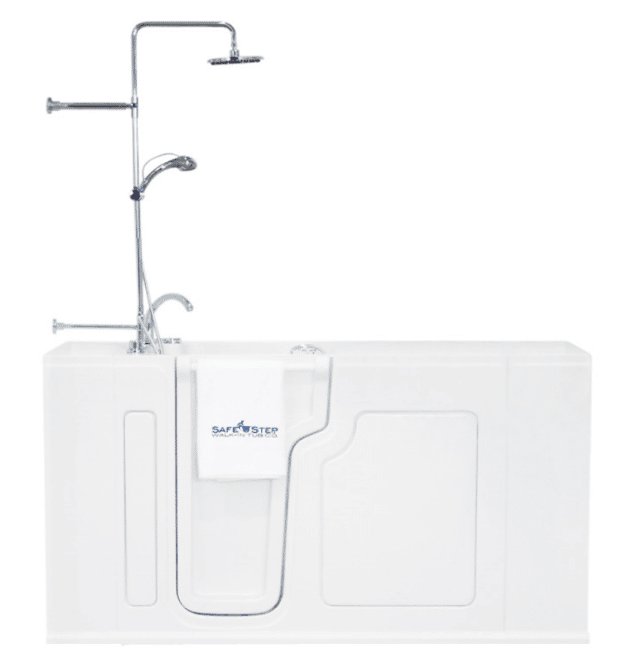
Learn more about the best walk-in tub-shower combinations in our full review.
Table 1 Comparison of walk-in tub prices by type, as of February 2023
Walk-in tub type | Starting price range |
|---|---|
| Soaker | $2,000–$5,000 |
| Whirlpool/Hydrotherapy | $3,000–$5,000 |
| Aerotherapy | $3,000–$5,000 |
| Wheelchair Accessible | $4,000–$7,000 |
| Bariatric | $4,000–$7,000 |
| Two-seaters | $8,000–$10,000 |
| Walk-in tub-shower combo | $3,000–$10,000 |
Walk-in tub material
Material also influences a walk-in tub’s price. Most walk-in tubs are made with either gelcoat, acrylic, or fiberglass.
Here are the three main types of materials used to manufacture walk-in tubs:
- Gelcoat: Gelcoat tubs are made with thin layers of lightweight polymer that makes this type the easiest to install. Unfortunately, gelcoat tubs are the first to break down with use.
- Acrylic: Acrylic tubs use layers of plastic reinforced with fiberglass to create a more durable tub that requires little to no maintenance, because they are not easily scratched or stained.
- Fiberglass: Fiberglass tubs use layers of glass fibers with plastic to create a tub that is more durable than a gelcoat, but prone to scratching and cracking compared to acrylic.
Gelcoat and acrylic walk-in bathtubs cost about the same, starting between $2,000–$7,000. Fiberglass tubs have a wider price range between $1,000–$12,000. If you’re looking for affordability and durability, consider acrylic tubs since they require the least maintenance at a lower cost.
ADA compliance
Not all walk-in tubs are compliant with the Americans with Disabilities Act (ADA). ADA compliance is only necessary in public spaces, so walk-in tubs don’t have to comply unless they are in nursing facilities. Some people may benefit from residential walk-in tubs that are ADA compliant because they meet accessibility standards for everyone, which means they will likely be accessible to you. ADA-compliant walk-in tubs meet or exceed the standards in Section 607 of the ADA, which include:4
- Clear floor space: Must be 30 inches wide and 60 inches long for obstruction-free access to the tub
- Seats: Must be present with a non-slip surface
- Grab bars: Must be present
- Shower: There must be a handheld shower unit, or a tower with a removable shower head
If you’re searching for an ADA-compliant walk-in tub, this may influence your total cost. ADA-compliant walk-in tubs will be larger than compact tubs for small bathrooms, which tend to be less expensive because they use less material. And if your bathroom needs to be more accessible, you may need to consider widening the floor space or reconfiguring your bathroom to meet ADA standards.
Walk-in tub brands
Each brand has a different price range depending on what they offer. Our Reviews Team determined which brands have financing to help lower the cost barrier.
If you want to make sure you’re purchasing everything you need, consider brands with free bathroom assessments, so a professional can measure your tub space and make recommendations according to your bathroom setup.
Keep in mind that some manufacturers also sell their products through dealers, so financing and bathroom assessments could depend on the retailer.
Table 2 Comparison of popular walk-in tubs, as of February 2023
| Brand | Starting price range (before installation | Financing | Free bathroom assessment |
|---|---|---|---|
| American Standard | $3,504–$8,622 | Yes | Yes |
| AmeriGlide | $2,493–$5,149 | Yes | No |
| Ariel | $1,999–$4,620 | Depends on retailer | Depends on retailer |
| Ella’s Bubbles | $3,888–$8,613 | Yes | Yes |
| Kohler | $2,000–$20,000 | Yes | Yes |
| Meditub | $1,899–$5,500 | Depends on retailer | Depends on retailer |
| Safe Step | In-home estimate required | Yes | Yes |
| Universal | $1,989–$6,039 | Depends on retailer | Depends on retailer |
How much does it cost to install a walk-in tub?
On average, installation can cost between $1,000–$10,000 depending on the amount of renovation. Large projects that require tub removal, bathroom expansion, or plumbing modifications can easily approach $10,000.
Most brands have one of two options:
- Request installation through the retailer. Many brands offer installation services through company technicians. If you opt for this, installation costs will be rolled into your quote.
- Select your own installer. Some brands sell the walk-in tub without installation. This means it’s your responsibility to premeasure your bathroom, order the right tub, and organize installation. You can Google walk-in tub installation in your local area to browse local technicians, but shop around to make sure you’re getting a fair price for the job.
Can I install my walk-in tub myself?
Although self-installation seems like a great money saver, it’s not recommended. Plumbers (and electricians if you’re installing a tub with jets) are involved in the installation process to make sure the tub is installed correctly.
Factors that influence the cost of walk-in tub installation
The Reviews Team called different brands to understand the installation costs and found that walk-in bathtub cost varies greatly between each one. For example, Kohler installation can be between $2,500–$8,000, while Meditub installation can cost between $7,999–$10,000.
When we asked what influences the walk-in tubs cost, most brands stated that installation is unique to your home and the tub that you buy. Removing an old tub and replacing it with a standard soaking walk-in tub will cost less than renovating the bathroom to fit a wide tub that needs electrical input for jets. Many installation prices are quoted after evaluating how much work needs to be done on the bathroom to fit the tub. Consider these costs that can increase your final installation price:
- Shower to tub conversion: If you have a shower and would like to remove it for a walk-in tub, you’ll pay about $3,000 on average depending on the extent of the job.
- Tub size: When installing a tub that’s larger than the current available space, your installer will need to make room by removing walls or counters and potentially changing plumbing location. This adds to cost, although estimates largely depend on the job.
- Plumbing and electrical upgrades: You can account for at least $1,000 to upgrade your pipes and add circuitry to accommodate a new walk-in tub that needs plumbing and electrical modifications.
- Water heater upgrade: If you need a larger water heater to supply your tub with warm water, you’ll pay at least $400, which is on the low end, for a 50–60-gallon water heater (the recommended size). Tankless household water heaters start above $500. You can find affordable water heaters on Lowe’s and Home Depot online stores. Replacing your current one will cost several hundred dollars for installation, plus the price of the new tank.
- Old tub removal: Removing an old tub typically costs no more than $1,000 depending on its size and weight. If it’s a simple removal, it may only cost a few hundred dollars.
You may need to look beyond walk-in tub installation if you want to improve accessibility to your bathroom. If you’ve chosen a wheelchair accessible tub, do you need to make your bathroom entrance wheelchair accessible by widening doors and pathways? Widening a door can cost $300–$800, but it can also cost more if you need to adjust more pathways in the bathroom. Although it’s not always necessary, remodeling a bathroom can cost anywhere between $5,000–$30,000 depending on the extent of the job.
Add-ons that influence the cost of walk-in tubs
You can customize most walk-in tubs with add-ons or optional features as part of your purchase, or as a separate investment after you purchase your tub. Some add-on features can enhance the safety of your tub while others may be luxury additions. You may want to exclude features that aren’t necessary, so you can save money on your tub. Be sure to evaluate your needs as you consider additional features.
“Grab bars are a standard that are recommended for anyone with any type of issues in the bathroom,” said Brittany Ferri, an occupational therapist based in Rochester, New York. “They are simply a good safety net to have if you feel unsteady, but they can also help when transferring in and out of the tub or shower. Hand-held showerheads are great for someone who wants to sit for the duration of their bathing session, so they don’t need to get closer to the showerhead or move around a lot to make adjustments.”
Here are some features, including grab bars and handheld showerheads, that may be helpful add-ons to your walk-in tub.
- Custom grab bars: Many tubs already come with grab bars, but not all grab bar placements work for everyone. If you want custom grab bars installed, you’ll pay several hundred dollars for the bar and labor.
- Textured, slip-resistant floors: Textured or rubberized floors can keep you from slipping. If your tub doesn’t come with this safety feature, you can buy a paint-on tub grip on Amazon for $32 or buy a mat for the tub floor.
- Fast filling and draining: Brands like Kohler offer faucets and drains that fill and drain the tub quicker than the standard 10–15 minutes. A “Fast Fill” faucet takes only 90 seconds to fill the tub, and a “Fast Drain” system drains the tub in only 60 seconds to four minutes depending on the product. Both features help save time during your bath and double as safety features in case you need to exit the tub urgently. Although fast fill faucets and fast drain systems are often included with your tub, some brands like Meditub offer these systems as add-on features, with starting costs at about $400 each.
- Overflow protection: Not all tubs come with an overflow drain, which can prevent your tub from overflowing if the faucet is left running. If your walk-in tub does not have overflow protection, specify with your retailer or installer that you’d like to install an overflow drain with your tub. Purchased separately, most overflow drains are between $100–$200.
- Outward-swinging door: Many tubs come with an inward swinging door, so the door doesn’t take up more space in the bathroom. This may be fine for some people, but it can be inconvenient if you need more space in the tub to enter and exit. Wheelchair accessible tubs open outward for easy transfer between the wheelchair and the tub seat. Many brands offer outward-swinging door models and allow you to specify door configuration at checkout, or you can inquire about outward-swinging doors during a home consultation. Keep in mind that outward-swinging doors are typically designed to accommodate people in wheelchairs or with larger body types, so some tubs with these doors could cost more.
- Hand-held showerhead: As Ferri explained, hand-held showerheads are a helpful tool if you want to stay seated during your bath. Most walk-in tubs include hand-held showerheads to meet ADA compliance, but if yours doesn’t, you can buy a tub deck-mounted hand-held showerhead from Home Depot for $40, plus applicable installation costs. It may be more affordable to look for a walk-in tub with this feature instead of adding it later, since you’ll have to purchase the showerhead and pay additional labor costs to adjust the tub’s plumbing.
- Heated backrest: Heated backrests are a great option to soothe aching muscles, but it’s not a necessary feature. If you’re looking to splurge on a luxury tub, brands like Ella’s Bubbles will let you add this to your purchase for $490. Don’t forget to account for electrical costs, like hiring an electrician to wire the heating system.
- Foot massager: This feature uses jets to massage aching feet or aid in relaxation. Foot massagers are more of a luxury as jets add thousands of dollars to a purchase. If you’re looking to splurge, you’ll easily spend above $5,000 for a tub with foot massage jets.
- Ozone sterilization: This is a method of deep cleaning the tub free of mold and bacteria. It uses ozone gas (which is natural, safe, and odorless) released from the hydrotherapy jets in the tub to interact with the dirt and grime and deep clean the tub, even in hard-to-reach places. If you have trouble cleaning low surfaces, or if you have multiple users and need to clean often, this is a great feature. You can purchase the ozone system (like micrOzone) for roughly $150 in some hydrotherapy tubs, which typically cost $3,000–$5,000.
You can also find therapeutic add-ons that aid in pain and stress relief. Research shows aromatherapy fragrance and natural properties of essential oils can aid in healing and positively influence mood.5 You shouldn’t cut corners on this one—if you plan to use essential oils in the bath, don’t place the oil directly into the tub or you’ll risk skin irritation or toxicity, according to the National Capital Poison Center.6 The oils could also make the surfaces slippery and increase the risk of slipping or falling. Tubs with aromatherapy have canisters to distribute the oil safely.
Another therapy sometimes included in walk-in tubs is chromotherapy, which uses wavelengths in colors to stop bacteria growth, promote cell regeneration, and aid in healing, according to research.7 Both aromatherapy and chromotherapy are found in tubs that start in the $3,000–$5,000 range.
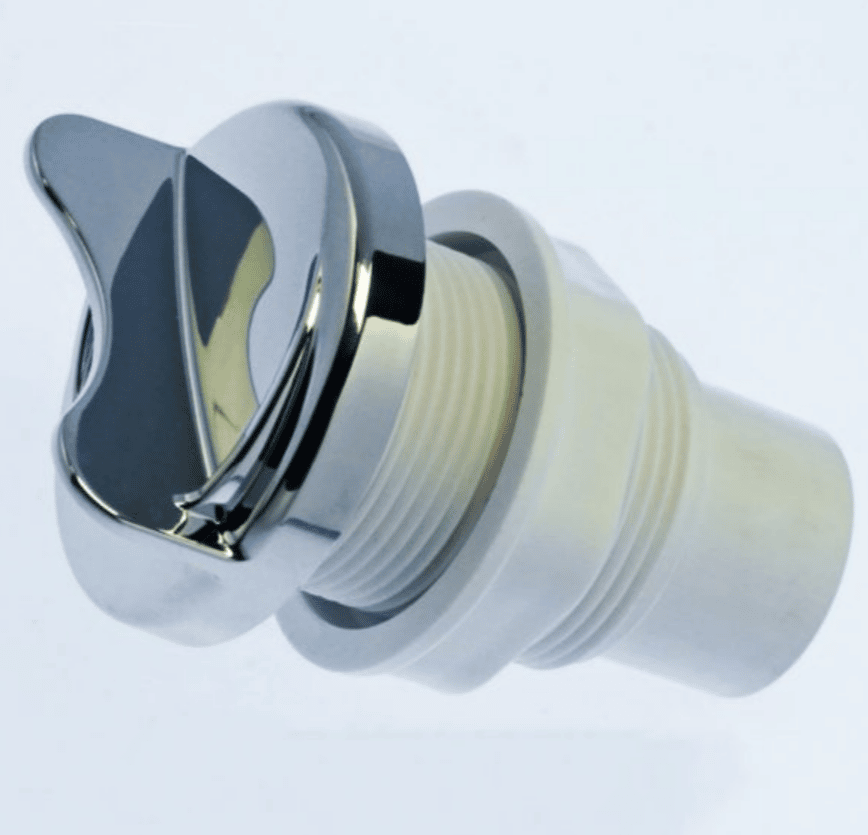
If you’re looking for other ways to receive these therapies, you can find substitutes online. Essential oil diffusers start at $30–$50, and colored light panels start around $60–$150. When in doubt, ask your doctor if you could benefit from either of these therapies. Take extra care using essential oils as they can interact with medications.
How much does it cost to maintain a walk-in tub?
Walk-in tubs can last up to 30 years, especially if they’re made from durable acrylic material. Luckily, maintenance doesn’t have to be expensive if you care for it regularly, which reduces bacteria growth, removes mold, and prevents erosion.
A vinegar and water mixture can clean any tub surface well without using expensive, harsh chemicals. Plan to clean your tub once per month—pour 2 cups of vinegar and 2 cups of water into an empty running bath with a plugged drain for 10 minutes. After 10 minutes, scrub the interior of the tub before emptying the water. You can use Dawn dish soap with water to clean areas that the vinegar solution can’t reach, like the fixtures and the outer tub walls. Just be sure to rinse off all cleaning solutions and soaps to remove dangerous slippery residue, which can cause a fall.
To save on maintenance costs like clogged drains, avoid using bath bombs that can clog the pipes, and clean the drains regularly from hair and dirt. You can also prevent tub erosion and extend the life of the product by avoiding abrasive scrubbing tools that can scratch the surfaces and trap grime.
Will insurance or Medicare cover the cost of a walk-in tub?
Private and government-funded insurances rarely cover the cost of a walk-in tub. Generally, walk-in tubs are not considered durable medical equipment (DME), and Medicare doesn’t include them in its approved list for coverage. But Medicare Part B and Medicare Advantage (Part C) may make exceptions. “They may offer some coverage if it’s deemed medically necessary and if more affordable alternatives (tub bench, shower chair, etc.) are not an option,” Ferri explained. It’s best to call and ask just in case your plan offers partial coverage under your unique circumstances.
If you have Medicaid, funding opportunities are available, although this differs from plan to plan. Some Medicaid programs will offer assistance for home modifications like walk-in tubs through Medicaid Home and Community Based Services waivers, which help cover at least part of your expense. Call your local Medicaid office to see how you can qualify for a waiver or any other programs available in your state.
If you’re having trouble finding insurance coverage, you can apply for local funding. Check online tools like NCOA’s BenefitsCheckUp to see what’s available in your area by entering your ZIP code and selecting the assistance you need. You can also see if you qualify for the U.S. Department of Agriculture’s (USDA) Rural Repair and Rehabilitation grants and loans that help low-income people upgrade their home, including accessibility modifications like a walk-in tub.

Another option is applying for local programs like Habitat for Humanity or Rebuilding Together. Your local area agency on aging or center for independent living can help connect you to these programs, and find assistance to help you purchase and install your walk-in tub if you qualify.
How to save money on walk-in tubs
If you don’t qualify for funding and you can’t claim insurance coverage, there are other opportunities to save on your walk-in tub and its installation.
Get an in-home assessment
Save money by purchasing only what you need the first time. Avoid costly mistakes by getting a free in-home assessment of your bathroom space by a professional. Assessments include measurements of the bathing space to make sure you’re getting the right size and door configuration. It also includes evaluating the entire bathroom area to make sure all pathways and doors accommodate your mobility needs.
Brands like Ella’s Bubbles and Safe Step send professionals to your home to measure your bathroom and discuss options specific to your space. If you want to browse different brands at once, try going to your local home improvement store like Lowe’s to discuss options. You can also call and schedule a home evaluation with a Lowe’s Project Specialist at 866-284-4008.
If you’re not sure what you need to accommodate your mobility needs, also consider an evaluation by a physical or occupational therapist. You can find occupational therapists with home modification experience at the Home Modification Occupational Therapy Alliance. They can help you decide if a walk-in tub is best for you and what customizations are worth purchasing. Or they may offer alternatives that are more effective and affordable.
Shop for discounts
Retailers like Safe Step offer discounts to military and older adults. Some brands also have limited-time offers, which can help you save on the product or installation.
Shop around and take advantage of any discounts or offers that can help reduce your walk-in tub cost. Look out for warehouse clearances on brand websites. Ella’s Bubbles has a warehouse clearance page full of walk-in tubs that are marked down by at least $1,000.
Look for financing options
Many brands like Safe Step, AmeriGlide, and Ella’s Bubbles offer financing options at various rates. Some brands offer financing depending on the retailer. Financing your walk-in tub can lower the initial cost barrier, but be aware that interest rates will likely make the walk-in tub more expensive in the long run.
Ask about price-matching
Companies like Lowe’s or Home Depot will match the price of any competitor selling the same tub. If you find a less expensive tub, these companies will lower the price of the same tub in their stock to win your purchase. Check out Lowe’s Price Promise to read more about how it works.
Get a tax refund
Walk-in tubs can be tax deductible. You’ll need to prove it was a medically necessary purchase by keeping your doctor’s prescription for the tub on hand. Keep the receipt for tax season and list your expense as an “itemized deduction” for medical purposes. You can find more information on the IRS website.
Where to shop for walk-in tubs
Walk-in tubs can be found online and from retailers nationwide. There’s a large selection of walk-in tub retailers, so finding the right one can be an overwhelming task.
The Reviews Team suggests starting by finding a retailer who can send a professional to do a free in-home evaluation, which can help you better understand what to look for as you shop. We recommend starting with Lowe’s or Home Depot, which are located nationwide and offer free evaluations and a wide range of options.
If you prefer to do your own research, most brands have websites where you can browse or purchase your tub online.
Best walk-in tub picks
Our Reviews Team picked the six best walk-in tubs on the market, but two are worth mentioning again for their relative affordability compared to other walk-in tubs.
AmeriGlide Sanctuary 2646
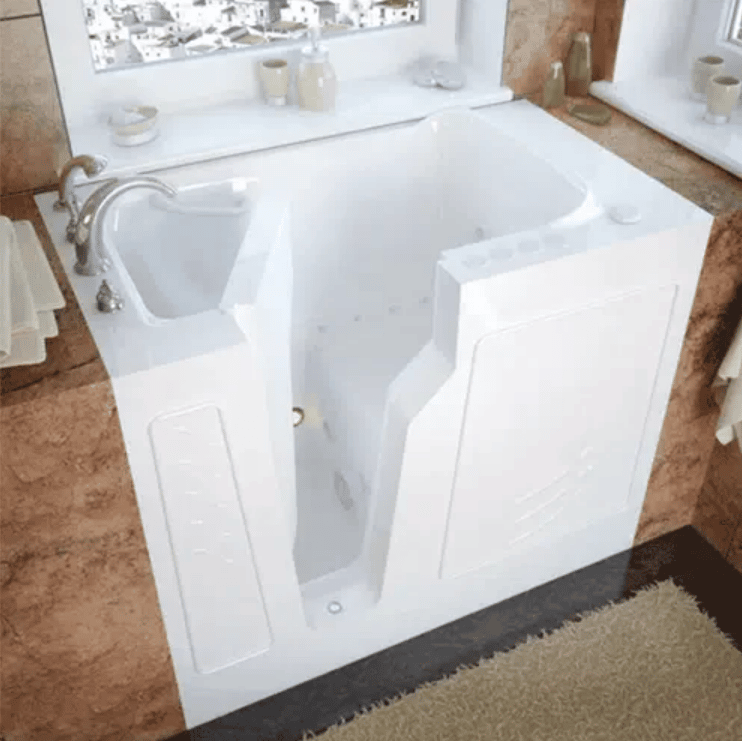
Although it’s a more expensive soaker at $3,361 before installation, AmeriGlide Sanctuary gives you a better warranty for the same features as the Ariel walk-in tub. It offers a lifetime warranty on the door seal, 10-year coverage on the tub, five-year coverage on the pump and motor, and one-year coverage on the faucet. This option is smaller than most, making it our pick for “Best Walk-In Tub for Small Spaces.” While this seat is 14.5 inches wide, standard models have at least 21 inch-wide seats, so this might feel tight. This model also comes with the gelcoat coating.
Call 800-580-0831, 8 a.m. to 5 p.m. ET, Monday through Friday to find out more. Or email AmeriGlide at customerservice@ameriglide.com.
Ella Transfer
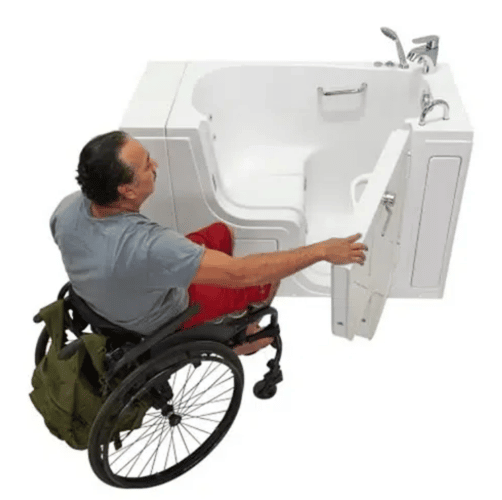
The Ella Transfer by Ella’s Bubbles is an ADA-compliant wheelchair accessible option with a 33–36-inch-wide outward-swinging door that creates an open passage, so you can transfer from a wheelchair to the tub seat. It starts at $4,673 with larger sizes available that add to the cost, but offer more room if necessary. The Ella Transfer comes with two grab bars and a nonslip floor, but it also offers a variety of add-on features that can improve safety and comfort, like jets, the ozone sanitation system, and tailored placement of grab bars.
Keep in mind that wheelchair-accessible tubs aren’t just for wheelchair users. If you’re concerned about clearing low thresholds, a wheelchair accessible tub could be the best solution because you can sit in a seat and pivot into the tub without stepping over obstacles.
Call 800-480-6850, 8 a.m. to 5 p.m. CT, Monday through Friday or 10 a.m. to 4 p.m. CT, on Saturdays to get more information. You can also chat with a live agent through the website, or contact the brand through email at: info@ellasbubbles.com.
Walk-in tub alternatives
If a walk-in tub doesn’t seem like the best option, there are alternative options that may be more affordable and can improve your access to bathing and showering.
Conversion kits
If you have a tub/shower combination, you can buy a conversion kit to change the tub wall into a door. AmeriGlide offers a conversion kit for $592, which involves cutting out a passage to step in and out of the tub. The door is optional since you can still shower standing and use a curtain to block the opening. If you plan to fill your tub, you’ll need to purchase the door at the online checkout, which is $230–$254 depending on the size. You can self-install it, but the Reviews Team recommends having a professional install it safely.
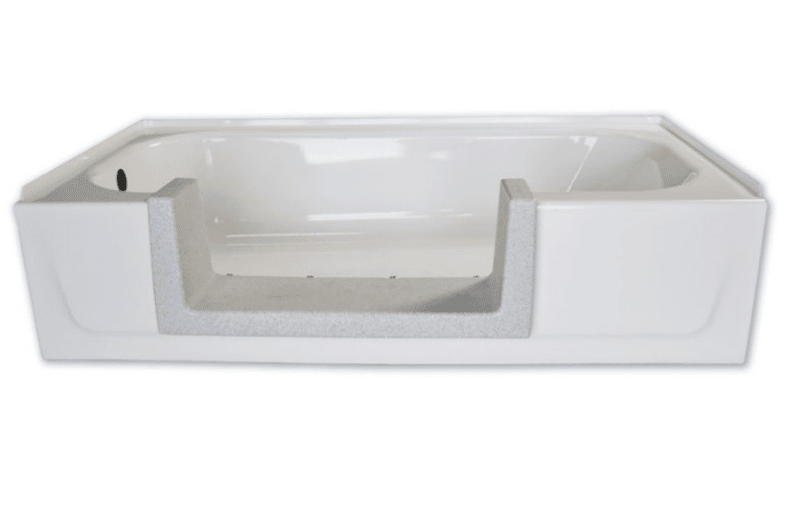
Transfer benches
If you’re looking for the most affordable way to safely enter and exit your tub, consider a transfer shower bench. Transfer benches are long, spanning the width of the tub and sitting slightly outside for easy access. “You can sit on one end positioned outside of the tub, swing your feet over the lip of the tub, and slide over into the tub,” Ferri explained.
Some benches come with back support (like a shower chair) while others do not—plastic benches are usually more affordable, and wooden ones are usually more expensive. You can order transfer benches online for around $100, although price can vary depending on the material. Look on CVS, Walmart, and Carewell online stores to find reputable brands like Maddak, which sells a few options with adjustable height and even pivot seats to make transferring easier. You can also go to your local Lowe’s and pick up the Drive transfer bench for about $80.
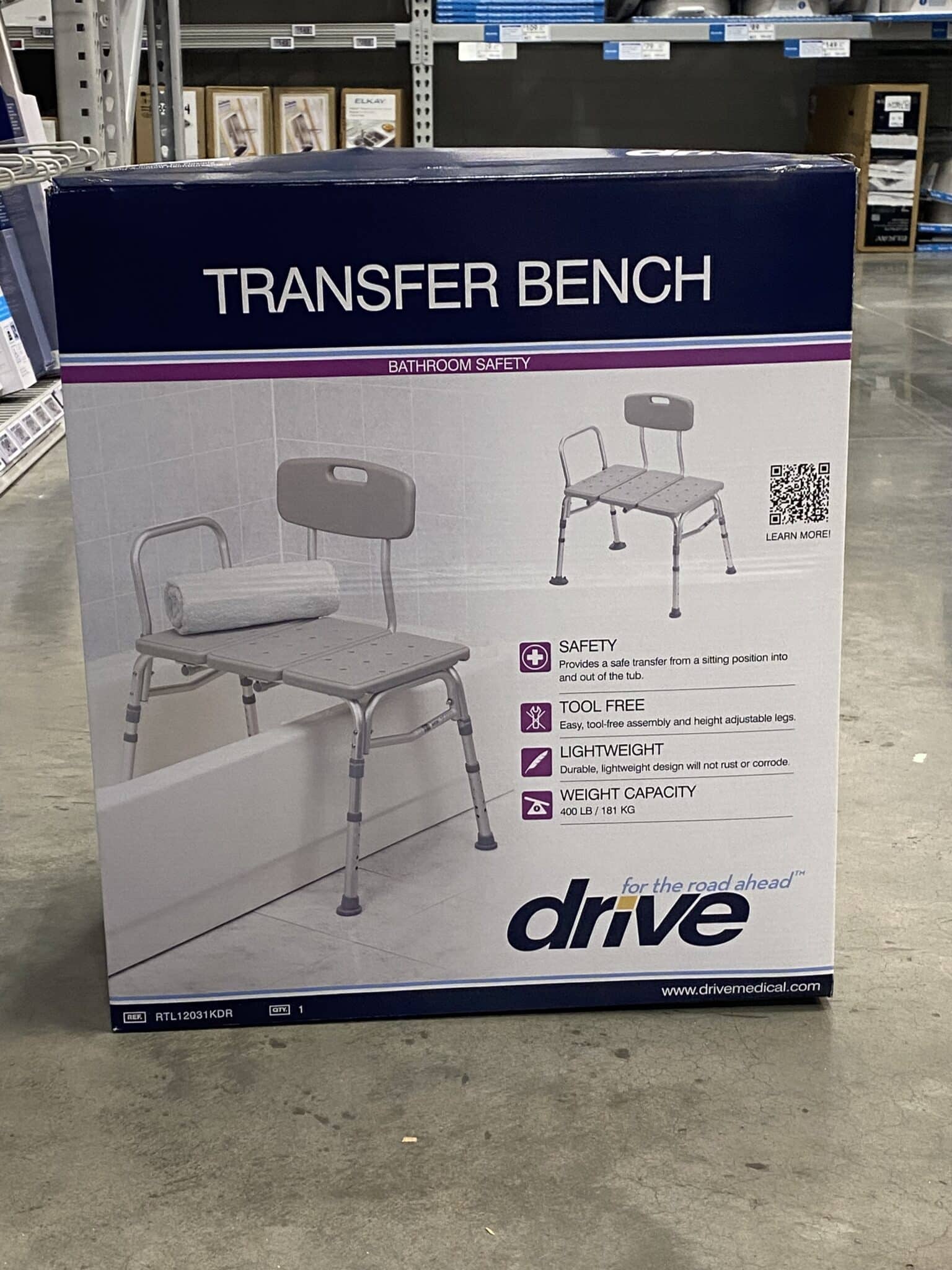
Bottom line
If you are wondering how much is a walk-in tub, prices start at $2,000–$10,000 before installation. While walk-in tubs are costly, they can help you stay safer and more independent in the bathroom. Before you purchase a walk-in tub, consider alternative options if they are appropriate. A transfer bench can serve as a more affordable solution, especially for short-term use. You can also opt for a conversion kit, which can turn your existing tub into a walk-in for a fraction of the price, but it doesn’t add jets or other therapeutics.
If a walk-in or wheelchair accessible tub is the best solution for you, there may be ways to find coverage or funding. Always start by asking your insurance provider, although coverage is rare. Next, check for local funding or programs using NCOA’s BenefitsCheckUp. And finally, save by looking for deals, discounts, financing opportunities, or price matching. You can also list your walk-in tub as a tax deduction during tax season.
Frequently asked questions
Walk-in tubs can range from $2,000–$10,000 before installation, although there are luxury tubs that can cost up to $20,000. Price depends on the size of the tub and added customizations. Keep in mind that installation costs can significantly increase the total cost, adding $1,000–$10,000, depending on the remodeling required to fit the tub into your bathroom.
Although we recognize walk-in tubs are a heavy investment, they are worth the money if it improves your safety and independence. Financing the walk-in tub, looking for deals and sales, or listing it as a tax deduction can help reduce the cost.
Costco customer support told our Reviews Team that they do sell walk-in tubs, although it depends on the warehouse location. Check your local warehouse’s stock through Costco’s website, or give them a call.
Medicare does not usually help with the cost of a walk-in tub because it does not qualify as covered DME, but there are other ways to cover cost. You can look into company discounts, financing options, and government funding opportunities through the USDA.
The main problem with a walk-in tub is the high cost with little to no health insurance coverage, so it can be too expensive for many people.
Have questions about this review? Email us at reviewsteam@ncoa.org.
Sources
- Centers for Disease Control and Prevention. Facts About Falls. Found on the internet at https://www.cdc.gov/falls/about/index.html
- Schellenber, M., et al. Falls in the Bathroom: A Mechanism of Injury for All Ages. Journal of Surgical Research. February 2019. Found on the internet at https://www.sciencedirect.com/science/article/abs/pii/S0022480418306656
- Al Qubaeissy, et al. The Effectiveness of Hydrotherapy in the Management of Rheumatoid Arthritis: A Systematic Review. Musculoskeletal care. March 2013. Found on the internet at https://onlinelibrary.wiley.com/doi/abs/10.1002/msc.1028
- U.S. Access Board. Americans with Disabilities Act Accessibility Standards. Found on the internet at https://www.access-board.gov/ada/#ada-607
- Thangaleela, S., et al. Essential Oils, Phytoncides, Aromachology, and Aromatherapy—A Review. Applied Sciences April 2022. Found on the internet at https://www.mdpi.com/2076-3417/12/9/4495
- Poison.org. Essential Oils: Poisonous When Misused. Found on the internet at https://www.poison.org/articles/essential-oils
- Azeemi, S. T. Y. et al. The Mechanistic Basis of Chromotherapy: Current knowledge and Future Perspectives. Complementary Therapies in Medicine. October 2019. Found on the internet at https://www.sciencedirect.com/science/article/abs/pii/S096522991930915X
